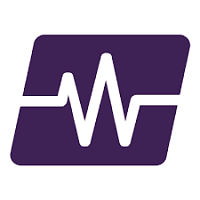Best Database Monitoring Tools
Best database monitoring software includes site24x7, cloudmonix, appstec DMS, backup ninja, and percona monitoring and management. Database monitoring software supports the ability to identify and report on fraudulent, illegal or other undesirable activities with minimal impact on user operations and productivity.



No Cost Personal Advisor
List of 20 Best Database Monitoring Tools
Category Champions | 2024
Full stack monitoring from the cloud
Site24x7 is an all-in-one cloud-based monitoring solution for DevOps, system engineers, sysadmins, and IT admins. It monitors websites, servers, networks, applications, and cloud services for businesses of all ranges, from startups and SMBs to large enterprises. Read Site24x7 Reviews
Explore various Site24x7 features, compare the pricing plans, and unlock the potential of seamless operations by selecting the right software for your business.
Features
View all Site24x7 Features- Trace individual transactions
- FTP Monitoring
- Real Time Monitoring
- Bandwidth Monitoring
- Web Logs
- Performance Metrics
- Root-Cause Diagnosis
- Uptime Monitoring
Pricing
Site24x7 Caters to
- StartUps
- SMBs
- Agencies
- Enterprises
The IT monitoring platform
Checkmk – Scalable, automated, and extensible monitoring for dynamic hybrid IT environments. With over 2,000 vendor-maintained plugins, Checkmk delivers comprehensive insights, providing you with a holistic view of your IT landscape like never before. Learn more about Checkmk
Explore various Checkmk features, compare the pricing plans, and unlock the potential of seamless operations by selecting the right software for your business.
Features
View all Checkmk Features- Policy-based automation
- SLA Monitoring
- Root-Cause Diagnosis
- Activity Log
- Secure remote access
- Capacity planning and optimization
- Database health monitoring
- Auto-discovery of devices and services
Pricing
Checkmk Caters to
- StartUps
- SMBs
- Agencies
- Enterprises
Emergents | 2024
Software by Paessler AG
PRTG is the powerful and complete website monitoring software. It monitors your network using a whole range of technologies and ensure the availability of network components and measures traffic and usage. Read PRTG Reviews
Explore various PRTG features, compare the pricing plans, and unlock the potential of seamless operations by selecting the right software for your business.
Features
View all PRTG Features- Transaction Monitoring
- Real Time Comparisons
- Data Management
- Email Monitoring
- IP Address Monitoring
- Application Monitoring
- Bandwidth Troubleshooting
- Performance Analytics
PRTG Caters to
- StartUps
- SMBs
- Agencies
- Enterprises
Emergents | 2024
Can handle 50,000 applications at a time
Stop doing manual application processing and automate tasks such as application upload, information re-check, and service delivery by using flexible application monitoring software, ManageEngine Applications Manager. It saves your time, efforts, and money. Learn more about ManageEngine Applications Manager
Explore various ManageEngine Applications Manager features, compare the pricing plans, and unlock the potential of seamless operations by selecting the right software for your business.
- CPU Monitoring
- Virtual Machine Monitoring
- Server Performance
- Uptime Reporting
- Applications Management
- Server Monitoring
- Event Logs
- Web Logs
ManageEngine Applications Manager Caters to
- StartUps
- SMBs
- Agencies
- Enterprises
Emergents | 2024
A complete cloud infrastructure platform for migra
A next-generation cloud infrastructure platform offering full range of services from migrating, building to running all your IT. It is perfectly designed to run any application, faster and more securely, for less. Learn more about Oracle Cloud Infrastructure
Explore various Oracle Cloud Infrastructure features, compare the pricing plans, and unlock the potential of seamless operations by selecting the right software for your business.
- Multi-Cloud Management
- Data Analysis
- Online Analytical Processing (OLAP)
- Big Data Analytics
- Data warehousing
- Application Development
- Data Integration
- Data Governance
Oracle Cloud Infrastructure Caters to
- StartUps
- SMBs
- Agencies
- Enterprises
Category Champions | 2024
Leading enterprise-grade relational database
Oracle Database is leading enterprise-grade relational database that offers secure data management and transaction processing. It provides organizations with enterprise-scale database technology stored in the cloud or on premises. Read Oracle Database Reviews
Explore various Oracle Database features, compare the pricing plans, and unlock the potential of seamless operations by selecting the right software for your business.
Features
View all Oracle Database Features- Data Synchronization
- Customer DataBase
- Data Analysis Tools
- Online Analytical Processing (OLAP)
- Data Entry Verification
- Backup
- Data Capture
- Large Database Maintenance
Oracle Database Caters to
- StartUps
- SMBs
- Agencies
- Enterprises
Contenders | 2024
Software by Datadog Inc
Datadog is the best assistance for cloud-scale monitoring. It is controlled by IT, operations, and developing organization who build and manage applications that run on dynamic or high-scale infrastructure. Read Datadog Reviews
Explore various Datadog features, compare the pricing plans, and unlock the potential of seamless operations by selecting the right software for your business.
Features
View all Datadog Features- Event-Based Notifications
- Event Logs
- Drag & Drop
- Customizable Dashboard
- FTP Monitoring
- Real Time Monitoring
- Report Export
- Drill Down
Pricing
Free
$ 0
Up to 5 Hosts
Pro
$ 15
Per Host/ Month
Datadog Caters to
- StartUps
- SMBs
- Agencies
- Enterprises
Contenders | 2024
Software by SolarWinds Worldwide LLC.
SolarWinds is a database software that includes remote access, asset tracking, backup, and monitoring. This DBMS has a nice user interface. It database system is trusted by a lot of users to create, retrieve, update and manage their data. Read SolarWinds Reviews
Explore various SolarWinds features, compare the pricing plans, and unlock the potential of seamless operations by selecting the right software for your business.
Features
View all SolarWinds Features- CPU Monitoring
- Scheduling
- Database Servers
- User Activity Monitoring
- Analytics
- Uptime Monitoring
- Alerts Notifications
- Real Time Monitoring
Pricing
Starter
$ 2995
Onetime
SolarWinds Caters to
- StartUps
- SMBs
- Agencies
- Enterprises
Contenders | 2024
Software by Red Gate Software
SQL Monitor is a fully featured Server Monitoring Software designed to serve Agencies, Startups. SQL Monitor provides end-to-end solutions designed for Web App. This online Server Monitoring system offers Database Servers, Event Logs, History Tracking, Patch Management, Virtual Machine Monitoring at one place. Read SQL Monitor Reviews
Explore various SQL Monitor features, compare the pricing plans, and unlock the potential of seamless operations by selecting the right software for your business.
Features
View all SQL Monitor Features- Database Servers
- History Tracking
- Patch Management
- Event Logs
- Virtual Machine Monitoring
SQL Monitor Caters to
- StartUps
- SMBs
- Agencies
- Enterprises
Emergents | 2024
Software by oracle
Oracle Enterprise Manager is a fully featured System Monitoring Software designed to serve Startups, SMEs, Enterprises. Oracle Enterprise Manager provides end-to-end solutions designed for Web App. This online System Monitoring system offers System Monitoring, Inventory Management, Policy-based Automation, Remote Monitoring at one place. Learn more about Oracle Enterprise Manager
Explore various Oracle Enterprise Manager features, compare the pricing plans, and unlock the potential of seamless operations by selecting the right software for your business.
- Remote Monitoring
- Inventory Management
- Policy-based automation
- System Monitoring
Oracle Enterprise Manager Caters to
- StartUps
- SMBs
- Agencies
- Enterprises
Contenders | 2024
Software by SentryOne
SQL Sentry is a fully featured Server Monitoring Software designed to serve SMEs, Enterprises. SQL Sentry provides end-to-end solutions designed for Web App. This online Server Monitoring system offers History Tracking, Database Servers, CPU Monitoring, Virtual Machine Monitoring, Event Logs at one place. Read SQL Sentry Reviews
Explore various SQL Sentry features, compare the pricing plans, and unlock the potential of seamless operations by selecting the right software for your business.
Features
View all SQL Sentry Features- Scheduling
- Virtual Machine Monitoring
- CPU Monitoring
- Database Servers
- Event Logs
- History Tracking
SQL Sentry Caters to
- StartUps
- SMBs
- Agencies
- Enterprises
Contenders | 2024
Software by Dynatrace
Dynatrace is one of the application performance management tools for greater productivity and efficiency. It offers performance metrics in real-time, error management, app & server metrics, monitoring cloud environments & infrastructure, and bug fix solutions. Read Dynatrace Reviews
Explore various Dynatrace features, compare the pricing plans, and unlock the potential of seamless operations by selecting the right software for your business.
Features
View all Dynatrace Features- Root-Cause Diagnosis
- Release Management
- Performance Control
- Resource Management
- Server Performance
- Diagnostic Tools
- Full Transaction Diagnostics
- Trace individual transactions
Dynatrace Caters to
- StartUps
- SMBs
- Agencies
- Enterprises
Emergents | 2024
Simple & Secure Database Backups
Backup Ninja is a cost effective and secure SaaS Service to backup, restore, monitor and manage popular open-source database backups effortlessly locally or in the cloud. Learn more about Backup Ninja
Explore various Backup Ninja features, compare the pricing plans, and unlock the potential of seamless operations by selecting the right software for your business.
Features
View all Backup Ninja Features- Dashboard
- Backup Scheduling
- Compression
- GDPR Compliance
- Secure Data Storage
- Encryption
- Incremental Backup
- Local Server Options
Pricing
Backup Ninja Pricing
$ 40
Agent/Month
Backup Ninja Caters to
- StartUps
- SMBs
- Agencies
- Enterprises
Emergents | 2024
Software by Nagios Enterprises LLC
Nagios produce complete monitoring of websites, web transactions, web applications, and web services including availability, HTTP status, URL monitoring, content monitoring, hijack detection, and more. Learn more about Nagios
Explore various Nagios features, compare the pricing plans, and unlock the potential of seamless operations by selecting the right software for your business.
Features
View all Nagios Features- Voice / SMS Alerts
- Applications Management
- Real Time Monitoring
- Mail Server Monitoring
- Database Servers
- Uptime Monitoring
- CPU Monitoring
- Event-Based Notifications
Pricing
Standard Edition
$ 1995
One Time
Enterprise Edition
$ 3495
One Time
Nagios Caters to
- StartUps
- SMBs
- Agencies
- Enterprises
Contenders | 2024
Software by Spiceworks Inc.
Spiceworks helps you run a ship-shape help desk, at the office and on the road. It acts as a customer service software and helps you manage user tickets. It intends to make the flow of your organization as streamlined as possible following the customer support virtue. Read Spiceworks Reviews
Explore various Spiceworks features, compare the pricing plans, and unlock the potential of seamless operations by selecting the right software for your business.
Features
View all Spiceworks Features- Third Party Integration
- Automated Routing
- Surveys & Feedback
- Self Service Portal
- Customer DataBase
- Document Management
- Community Forums
- Knowledge Base
Spiceworks Caters to
- StartUps
- SMBs
- Agencies
- Enterprises
Contenders | 2024
Software by Zabbix LLC
Zabbix is an effortless open source monitoring resolution for performance management It is already used by a vast number of companies who have accepted it due to real scalability, high and robust performance, ease of use and greatly low costs of buying. Read Zabbix Reviews
Explore various Zabbix features, compare the pricing plans, and unlock the potential of seamless operations by selecting the right software for your business.
Features
View all Zabbix Features- Employee Profile
- Balanced Scorecards
- Qualitative Analysis
- Employee Management
Zabbix Caters to
- StartUps
- SMBs
- Agencies
- Enterprises
Emergents | 2024
Software by MariaDB
MariaDB is a fully featured Database Management Software designed to serve Agencies, Startups. MariaDB provides end-to-end solutions designed for Windows. This online Database Management system offers Access Controls/Permissions, Backup and Recovery, Data Replication, Multiple Programming Languages Supported, Performance Analysis at one place. Learn more about MariaDB
Explore various MariaDB features, compare the pricing plans, and unlock the potential of seamless operations by selecting the right software for your business.
Features
View all MariaDB Features- Performance Analysis
- Access Controls/Permissions
- Data Management
- Multiple Programming Languages Supported
- Dashboard
- Data Replication
- Backup and Recovery
MariaDB Caters to
- StartUps
- SMBs
- Agencies
- Enterprises
Emergents | 2024
Software by AppDynamics
The innovative server monitoring tool, AppDynamics, will help you out to make most out of CPU utilization. You can easily integrate business transaction and content by connecting this leading server monitoring software with your core operating system. Read AppDynamics Reviews
Explore various AppDynamics features, compare the pricing plans, and unlock the potential of seamless operations by selecting the right software for your business.
Features
View all AppDynamics Features- Real Time Monitoring
- Scheduling
- Virtual Machine Monitoring
- History Tracking
- Applications Management
- Database Servers
- Email Monitoring
- Real Time Comparisons
AppDynamics Caters to
- StartUps
- SMBs
- Agencies
- Enterprises
Contenders | 2024
All-in-One IT Management Software
Atera IT is a process automation software that helps MSPs and IT service providers of all sizes with integration, automation, and business processes. This cloud-based software offers Backup and Recovery, Billing & Invoicing, and Issue Management. Read Atera Reviews
Explore various Atera features, compare the pricing plans, and unlock the potential of seamless operations by selecting the right software for your business.
Features
View all Atera Features- Baseline Manager
- Scheduling
- Live Chat
- Inventory Management
- Event Logs
- Ticket Management
- Issue Management
- SLA Monitoring
Pricing
Pro
$ 99
Per User
Atera Caters to
- StartUps
- SMBs
- Agencies
- Enterprises
Emergents | 2024
Software by Opsview Ltd
Website monitoring can be set up quickly in Opsview Monitor providing total end-to-end monitoring of websites, web applications, web transactions and web services - including availability, URL monitoring, content monitoring, hijack detection and more. Learn more about opsview
Explore various opsview features, compare the pricing plans, and unlock the potential of seamless operations by selecting the right software for your business.
Features
View all opsview Features- Virtual Machine Monitoring
- Mail Server Monitoring
- Application Monitoring
- Uptime Monitoring
- User Activity Monitoring
- Voice / SMS Alerts
- Real Time Monitoring
- Event Logs
Pricing
FREE Plan
$ 2
Free Forever
SMB Plan
$ 2
Host/Month
Enterprise Plan
$ 5
Host/Month
opsview Caters to
- StartUps
- SMBs
- Agencies
- Enterprises
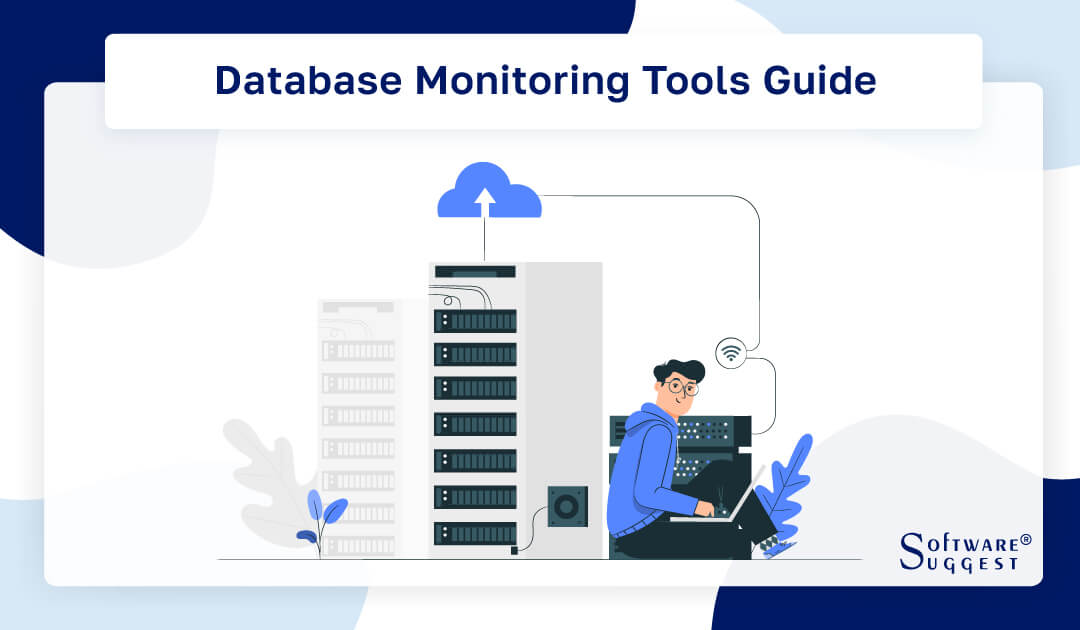
Are you in search of comprehensive insights into the top-rated database monitoring tools? If your organization relies heavily on databases, you're undoubtedly aware of the paramount importance of ensuring their seamless performance. In this guide, we aim to provide you with a detailed exploration of the leading database monitoring tools available in the market.
This buyer guide is curated to offer a comprehensive analysis of these db monitoring tools, encompassing their functionalities and methodologies. Irrespective of your level of technical expertise, our guide will serve as an indispensable resource to assist you in selecting the ideal database monitoring tool tailored to your unique requirements.
What Are Database Monitoring Tools?
Database monitoring tools are software applications designed to continuously track and manage the performance, availability, and security of databases within an organization's IT infrastructure. These tools systematically monitor various aspects of a database, such as query execution, resource utilization, data storage, and user access.
It is to ensure smooth operations and proactively detect and address any potential issues or anomalies. Database monitoring software offers alerts, reports, and dashboards. Data pros use them to decide, simplify maintenance, and avoid downtime or breaches. They automate monitoring and ensure data system integrity in complex IT settings.
Benefits of The Best Database Monitoring Tools
Database performance monitoring tools play a pivotal role in ensuring that databases perform optimally, remain secure, and deliver a seamless user experience. Now, we'll delve into the various benefits offered by the best database monitoring system.
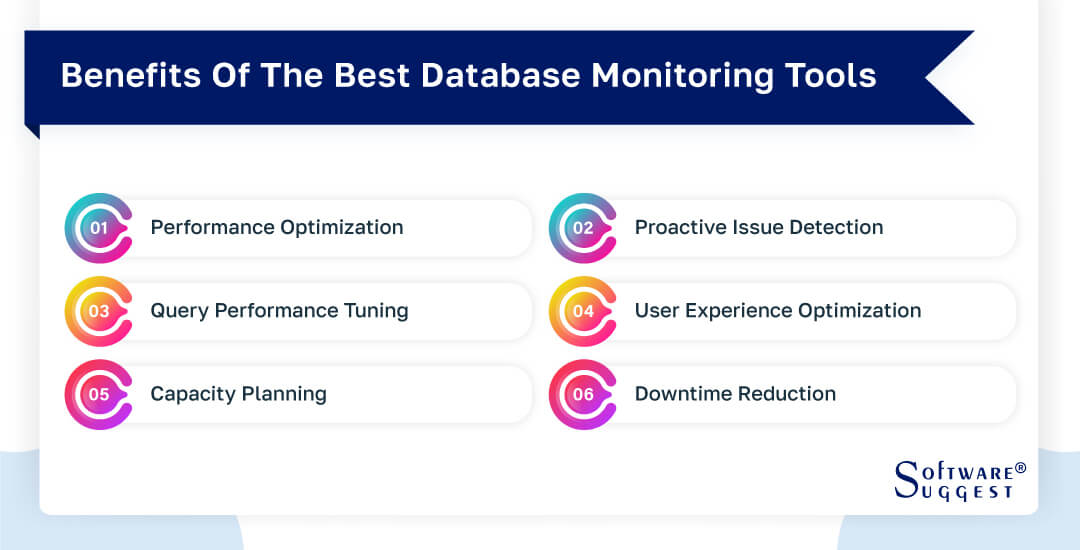
-
Performance optimization
The best database monitoring tools excel at performance optimization, a key factor in ensuring that databases run efficiently. These tools keep a close eye on various aspects of database performance, such as response times, query execution, and resource utilization, providing valuable insights to database administrators about the overall health and performance of their databases. The capacity of these network monitoring tools to pinpoint areas for improvement is one of its main advantages.
They can identify resource-intensive operations, slow queries, and wasteful database schema design. With this information, database administrators can optimize performance proactively. Some database monitoring technologies provide real-time warnings and notifications. These technologies can promptly warn administrators of performance threshold breaches or anomalies.
-
Proactive issue detection
Database monitoring solutions excel at proactive issue detection, helping establishments identify and resolve potential problems before they escalate. These database performance tools continuously monitor database health, tracking key performance indicators, system logs, and security events. One of the significant advantages of proactive issue detection is its ability to catch issues early, preventing them from causing major disruptions.
For instance, if a database experiences increased query response times or a sudden spike in resource usage, monitoring tools can raise alerts. Administrators can then investigate the root cause and take corrective actions, such as optimizing queries or reallocating resources. Database monitoring tools are also adept at identifying security threats and unauthorized access attempts.
-
Query performance tuning
Query performance tuning is a core aspect of database optimization, and database monitoring tools are instrumental in this endeavor. These tools designed for SQL server databases offer in-depth insights into query execution, granting administrators the capability to optimize SQL queries for peak performance. Utilizing these monitoring tools, administrators can evaluate query execution plans, pinpoint lengthy query processes, and gauge resource usage.
Two examples of SQL Server database instances are AdventureWorks, which contains data for a fictional company, and Northwind, which simulates data for a small food distribution company. The advantages of enhancing query performance are diverse and culminate in swifter query response times.
-
User experience optimization
User experience optimization is a top priority for organizations relying on databases to power their applications. Database performance tools play a vital role in achieving this goal by ensuring that applications deliver fast, consistent, and reliable performance to end-users. These database monitoring services monitor key performance indicators that directly impact user experience, such as response times, query execution, and system availability.
Administrators can detect user experience concerns like delayed queries and resource bottlenecks by tracking these indicators in real-time. Proactively fixing errors is a major benefit of database monitoring for user experience optimization. Administrators can act quickly when monitoring tools reveal performance degradations or anomalies.
-
Capacity planning
Capacity planning is a critical aspect of database management, and database monitoring tools are indispensable for this task. These database performance tools provide valuable insights into resource utilization, growth trends, and capacity limits. Thus enabling establishments to make informed decisions about scaling their databases. Monitoring tools continuously track resource consumption, including CPU, memory, storage, and network bandwidth.
They also collect historical data, allowing administrators to analyze usage patterns and forecast future resource requirements. One of the key benefits of capacity planning with database monitoring tools is cost optimization. When establishments carefully look at what they need, they can save money. They won't spend too much or have problems because they didn't get enough of what they need.
-
Downtime reduction
Downtime can be detrimental to business operations, productivity, and customer trust. Database performance monitoring tools play a crucial role in reducing downtime by proactively identifying and addressing issues that could lead to service interruptions. These tools continuously monitor database availability and performance, raising alerts when anomalies or potential problems are detected.
This early warning system empowers administrators to take immediate action to prevent or mitigate downtime. One of the significant benefits of downtime reduction through database monitoring is improved reliability. By minimizing unplanned outages, organizations can ensure that critical systems and applications remain accessible to users.
Features Of The Best Database Monitoring Tools
In the world of data management, having the best PDM Software to make sure your databases work well and stay safe is really important. Let's explore the important features of specialized database monitoring tool.
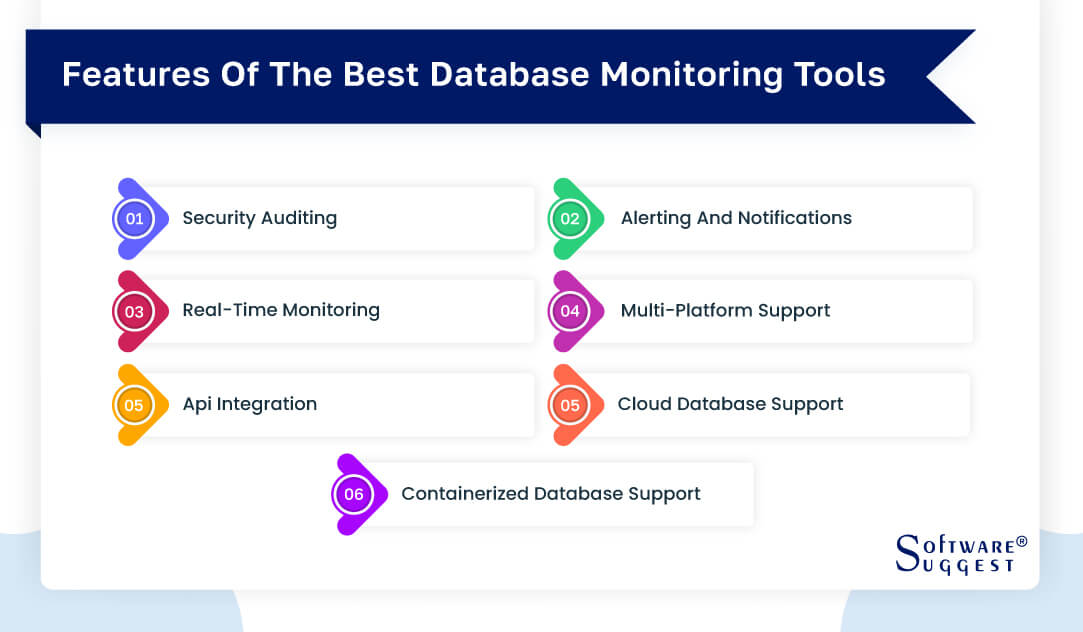
-
Security auditing
In the ever-evolving landscape of data security, advanced database monitoring tools take center stage with their comprehensive security auditing capabilities. These free and open-source monitoring tools empower organizations to maintain a meticulous record of user activities, granting administrators invaluable insights and key metrics into potential security breaches.
By generating detailed logs and reports, they not only bolster data integrity but also ensure strict compliance with industry regulations and security standards. This proactive approach allows organizations to detect and address security threats promptly, safeguarding sensitive information and preserving the trust of clients and stakeholders while mitigating the risk of data breaches.
-
Alerting and notifications
Database administrators depend on the finest monitoring tools equipped with robust alerting and notification systems. These SQL server health monitoring tools serve as vigilant guardians, swiftly transmitting critical event information and performance irregularities to administrators' attention. This real-time communication enables immediate responses to emerging issues.
Thus effectively minimizing downtime and guaranteeing the uninterrupted functionality of database systems. In today's fast-paced digital world, these alerting features are indispensable for maintaining system reliability and availability, ensuring that organizations can promptly address any anomalies and deliver uninterrupted services to their users.
-
Real-time monitoring
Real-time monitoring is an essential component of efficient database management and an indispensable tool for administrators who are looking to achieve peak performance. Real-time monitoring solutions supply administrators with a continual stream of insights about the performance of databases, enabling the administrators to respond to issues as they arise.
The graph database platform offers live dashboards and up-to-the-minute performance metrics, granting administrators immediate visibility into the health and operation of their databases. Such proactive measures prevent potential disruptions and bottlenecks, enhancing overall system efficiency and ensuring that organizations can meet the demands of a rapidly changing digital landscape.
-
Multi-platform support
In the complex ecosystem that is database management systems, versatile monitoring solutions that are compatible with several platforms stand out as particularly useful. These data center management software can adapt to different database setups, which enables administrators to efficiently monitor and manage a variety of different systems.
This flexibility reduces operational complexity and streamlines monitoring processes across the entire organization's database landscape. By offering consistent support for a range of database technologies, multi-platform monitoring tools empower businesses. They help maintain database performance and reliability without being constrained by the limitations of a single platform.
-
API integration
At the core of modern CMDB software lies the seamless integration of APIs, facilitating smooth connections between applications and systems. This integration simplifies processes, leading to improved efficiency and enhancing the synergy between database systems and the broader IT infrastructure. Thus, using the Microsoft data platform can be an option to optimize your establishment data.
Administrators can automate tasks, access additional data sources, and orchestrate complex processes, all while centralizing their database management efforts. API integration ensures that establishments can harness the full potential of their data. It is by seamlessly integrating it with other mission-critical systems facilitating data-driven decision-making.
-
Cloud database support
As businesses embrace the cloud for their database needs, leading cloud storage software extends their capabilities to cater to this dynamic environment. These tools provide specialized monitoring and management features tailored to popular cloud platforms. This ensures that administrators can maintain visibility and control over their databases in the cloud.
It is just as they would with on-premises solutions. With the ability to monitor database performance in the cloud, organizations can optimize their cloud-based infrastructure, enhance data availability, and ensure the seamless delivery of services while adapting to the evolving demands of the digital era.
-
Containerized database support
Containerization has revolutionized the deployment of databases by offering efficiency and scalability. By recognizing the significance of containerized databases, top-tier master data management software provides dedicated support for containerized environments. This support empowers administrators to monitor and optimize performance within containerized setups effectively.
By doing so, establishments can harness the benefits of containerization while ensuring the stability, security, and optimal performance of their databases. This proactive approach enables businesses to embrace modern containerization practices while maintaining the integrity and efficiency of their database systems.
How To Select The Right Database Monitoring Software?
Database monitoring software plays a crucial role in ensuring the performance, security, and reliability of these critical data repositories. Choosing the right NoSQL database platform can be a complex task. Let's see how to select one.
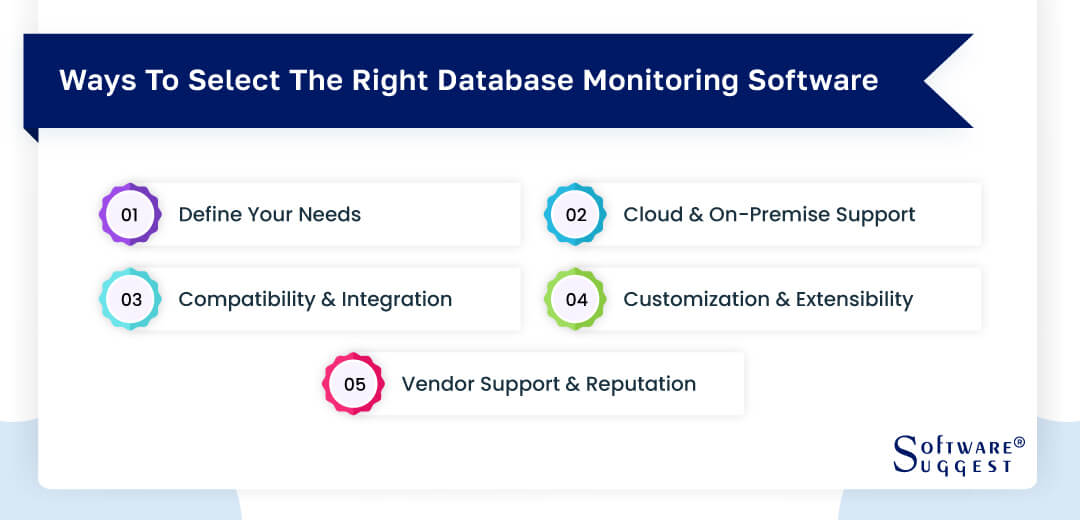
-
Define you needs
Defining your organization's specific database monitoring needs is a crucial first step in the selection process. This involves identifying the types of databases in your environment, whether they are relational databases like MySQL or NoSQL databases like MongoDB. You should also assess the scale of your database infrastructure, whether it's a few databases or a large distributed environment.
Clarify your monitoring goals, whether they focus on performance optimization, security auditing, or both, by pinpointing key performance indicators (KPIs) and security metrics. If your industry demands compliance with regulations like HIPAA or GDPR, ensure the chosen software aligns with these requirements.
-
Cloud & on-premise support
When considering database monitoring software, a critical decision revolves around the deployment model: cloud-based or on-premise. Cloud-based solutions offer scalability, allowing organizations to effortlessly adapt to changing workloads and data volumes, making them suitable for dynamic environments.
They provide remote accessibility, making it easier for distributed teams to manage databases. On the other hand, on-premise solutions grant organizations greater control over data and infrastructure but might require higher upfront investments. Consider your organization's growth projections, accessibility needs, budget constraints, and data sensitivity.
-
Compatibility and integration
Effective database monitoring hinges on seamless integration with your existing technology stack. To make an informed choice, ensure that the selected monitoring software aligns with your database management systems, whether relational or NoSQL. Compatibility with various operating systems is crucial, ensuring it functions optimally within your server infrastructure.
Evaluate the software's ability to integrate with third-party tools and business intelligence solutions, as these integrations can streamline your monitoring efforts and enhance data visualization. Additionally, consider whether the software supports APIs or scripting for custom integration, granting you the flexibility to tailor the monitoring solution to your organization's unique needs and workflows.
-
Customization and extensibility
Every organization's database monitoring requirements are distinct, demanding a solution that can be customized and extended to meet specific needs. Look for monitoring software that permits customization of alerting thresholds and notification methods, enabling you to align alerts with your organization's precise criteria.
Tailorable dashboards are invaluable, allowing you to focus on the most relevant metrics and data. Access to scripting and automation capabilities empowers you to create custom monitoring scripts or automate routine tasks, saving time and resources. Plugins or extension support further enhances customization by expanding the software's functionality to adapt to evolving needs.
-
Vendor support and reputation
Vendor support and reputation are pivotal considerations in selecting database monitoring software. Begin by evaluating the vendor's experience and track record in the database monitoring industry. A well-established vendor with a history of providing reliable solutions often instills confidence in product performance and customer satisfaction.
Responsive customer support is crucial for addressing issues promptly and efficiently. To gain insights into the software's real-world performance and reliability, research user reviews, testimonials, and community discussions about the product. Additionally, inquire about the vendor's update and maintenance schedule.
Best Practices To Implement In Database Monitoring
Effective database monitoring is a critical component of maintaining the performance, security, and reliability of your database systems. Let's explore essential best practices for successful database monitoring.
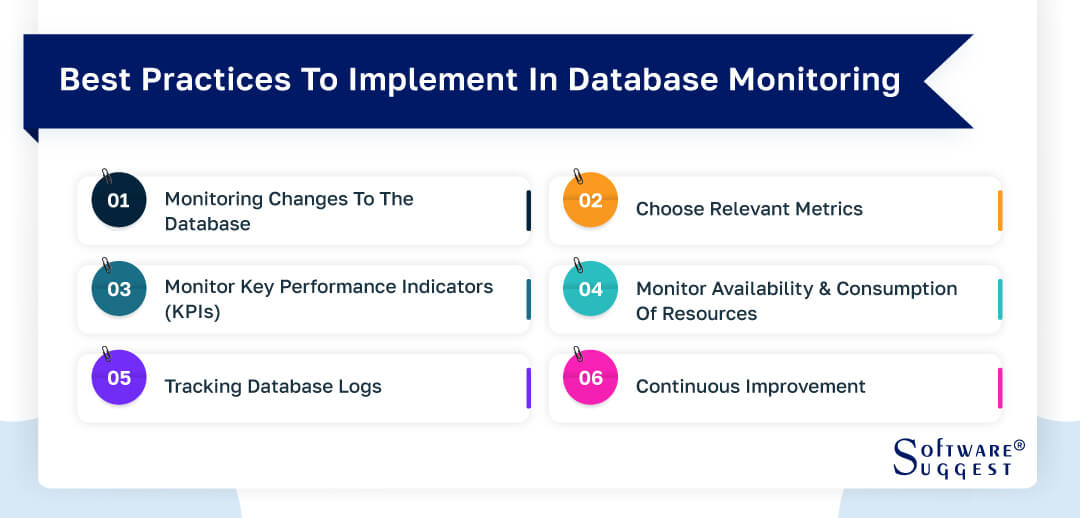
-
Monitoring changes to the database
Using SQL power tools and monitoring changes to your database is a fundamental practice to maintain data integrity and system stability. It involves tracking modifications to critical database elements like schema, tables, stored procedures, and more. By doing so, you can promptly identify and address issues stemming from code changes, unintentional modifications, or unauthorized access.
This method is quite thorough, and as a result, it helps protect the accuracy of data and strengthens compliance efforts. It is by giving a detailed historical record of alterations made to the database. Monitoring alterations is the most fundamental way to guarantee that your database will continue to be dependable and safe.
-
Choose relevant metrics
Good database management begins monitoring databases with smart choices about which database aspects to watch closely. Managing too much data can make monitoring challenging, so it's wiser to focus on the essential elements that significantly affect the performance of your SQL databases. These crucial factors may encompass your query performance and response time.
Also, how well your computer's resources like the CPU and memory are used (resource utilization), and how many transactions your database can handle in a given time (throughput). By concentrating on these important things, you can make your database work better and keep it reliable for a long time.
-
Monitor key performance indicators (KPIs)
Key performance indicators (KPIs) act as navigational tools in the realm of database monitoring. They offer concise snapshots of your database performance data. Vital KPIs include uptime, latency, error rates, and throughput. Ongoing monitoring of these KPIs provides real-time insights into your database's status, allowing you to assess its efficiency and effectiveness.
This technique is of the utmost importance for ensuring that your database constantly outperforms performance benchmarks while avoiding downtime and disruptions. This, in turn, ensures a seamless and efficient database operation that satisfies the ever-evolving expectations of your organization.
-
Monitor availability and consumption of resources
Resource availability and consumption are pivotal factors in the realm of database monitoring. Ensuring that your database systems are well-equipped with essential resources, such as CPU, memory, storage, and network bandwidth, is critical for sustaining optimal performance and preempting bottlenecks.
This practice encompasses setting resource utilization thresholds and strategically planning for capacity based on resource usage patterns. Also, it includes judiciously allocating resources in alignment with workload requirements. By focusing on resource management, you ensure the seamless operation of your database. Thus safeguarding it against performance degradation and facilitating scalability.
-
Tracking database logs
Database logs constitute a treasure trove of invaluable information for monitoring and troubleshooting. They offer meticulous records of database activities, encompassing queries, errors, and security-related events. Consistently reviewing logs, implementing alerting mechanisms based on log data, and harnessing logs for security auditing and compliance are foundational practices.
These activities empower you to identify issues promptly, track user actions, and maintain stringent security measures while preserving data integrity. In essence, tracking database logs serves as an essential safeguard, ensuring your database remains resilient, secure, and reliable in the face of evolving challenges.
-
Continuous improvement
Database monitoring is a continuous journey of enhancement. It necessitates continuous efforts to accommodate ever-changing workloads, improve overall performance, and fortify security precautions. This requires conducting regular audits of the metrics and key performance indicators that have been selected. It is to ensure that they are in line with the ever-evolving database performance goals.
Additionally, it involves optimizing queries and indexes based on performance data and keeping your monitoring tools up-to-date to leverage the latest features. Embracing continuous improvement ensures proactive database management, reduces downtime, and aligns decision-making with evolving business needs.
Issues That Can Be Detected Using Database Monitoring
Database monitoring using RDBMS software is a vital practice for ensuring the performance, security, and integrity of your database systems. Let's explore the key issues that can be detected through effective database monitoring.
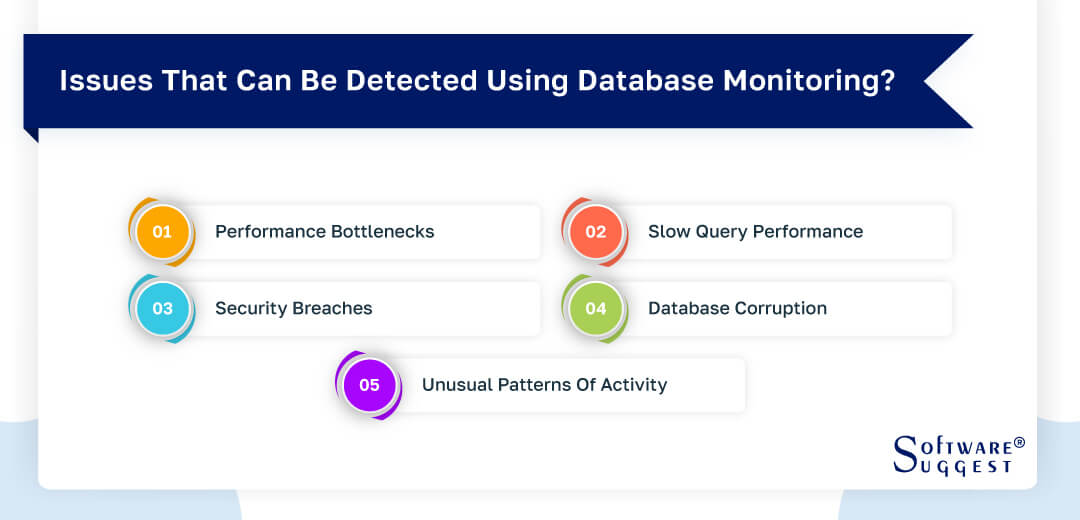
-
Performance bottlenecks
Performance bottlenecks are a frequent challenge that database monitoring can effectively identify. These bottlenecks materialize when specific operations or queries slow down or even paralyze the database. By diligently observing performance metrics like CPU usage, memory utilization, and disk I/O, you can discern the precise source of the bottleneck.
Also, you can initiate measures to optimize overall database performance. For instance, a poorly optimized query consuming excessive CPU resources can be detected and rectified through optimization, alleviating the bottleneck and enhancing the overall efficiency of the database.
-
Slow query performance
Slow query performance represents a critical facet of performance bottlenecks warranting special attention in database monitoring. Monitoring tools can meticulously track the execution time of individual queries, allowing for the identification of queries that are executing too slowly. Sluggish queries can substantially impede application performance and user experience.
Database monitoring empowers you to spot these problematic queries, scrutinize their execution plans, and undertake optimization efforts to enhance response times. This proactive approach guarantees that your applications operate seamlessly and efficiently, delivering an improved user experience and system responsiveness.
-
Security breaches
Database monitoring serves as a pivotal defense against security breaches, proficiently detecting and mitigating potential threats. It can unearth unauthorized access attempts, atypical login patterns, and suspicious activities within the database. By vigilantly tracking security-related events and scrutinizing user authentication logs, you can swiftly unearth and counteract potential security risks.
For instance, repetitive failed login attempts originating from an unfamiliar IP address could signify a hacking endeavor. Database monitoring promptly triggers alerts and notifications, enabling administrators to take swift action, fortify database security, and forestall data breaches. Thus safeguarding sensitive information and preserving the trust of stakeholders.
-
Database corruption
Database corruption poses a substantial risk stemming from hardware failures, software glitches, or unforeseen system crashes. Database monitoring tools are adept at identifying corruption by continually scrutinizing database file integrity and detecting inconsistencies. Upon detecting corruption, these monitoring tools trigger alerts and provide precise information about the affected database elements.
Early detection is crucial to mitigate data loss and preserve data integrity. Database administrators can then initiate recovery and repair procedures, restoring the database to a robust and healthy state safeguarding against the potential erosion of critical data.
-
Unusual patterns of activity
Database monitoring excels in uncovering unusual activity patterns within the database, which may hint at various underlying issues, such as security breaches, data anomalies, or application errors. By employing database monitoring tools to analyze user access patterns, transaction volumes, and query loads, deviations from normal behavior are readily identified.
For instance, a sudden surge in write operations may signify a data import or a potential data manipulation attempt. The detection of these irregular activity patterns enables administrators to delve deeper, ascertain root causes, and undertake appropriate actions. It is whether it involves resolving technical issues or addressing security concerns, thereby preserving the database's integrity and reliability.
Latest Market Trends In Database Monitoring Tools
Data monitoring tools have become increasingly important in recent years as organizations rely more heavily on data and databases to drive their operations. The global market for database monitoring software is projected to grow from $2.05 billion in 2024 to $5.61 billion by 2030 at a CAGR of 15.5%.
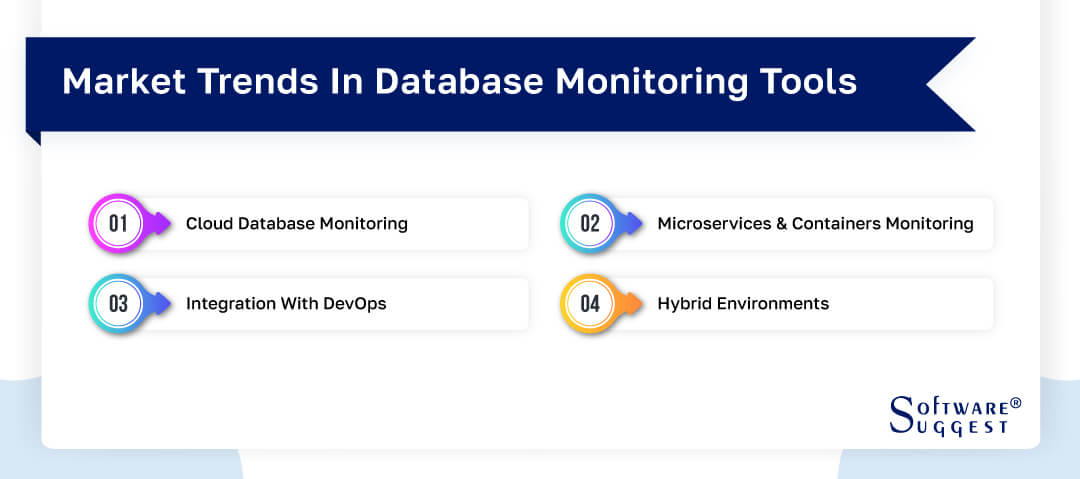
-
Cloud Database Monitoring
Cloud database monitoring is the process of continuously collecting metrics and tracking the health of containerized applications and microservices environments in the cloud. Containers have become one of the most popular ways to deploy applications. The global market for cloud-based database monitoring software is expected to grow at a CAGR of 14.9% from 2024 to 2029.
-
Microservices and containers monitoring
Microservices and container monitoring is the process of collecting metrics on microservices-based applications running on a container platform. The global market for container monitoring software is expected to grow at a CAGR of 14.7% from 2021 to 2031. Some of the top microservices and container monitoring tools include IBM Instana, Dynatrace, and Monte Carlo.
-
Integration with DevOps
DevOps is the process of monitoring everything from strategy to development, from integration to testing, and from deployment to operations. It provides a comprehensive, real-time view of the status of production applications, services, and infrastructure. Database monitoring tools can be integrated with DevOps to provide real-time insights into the performance of databases and applications.
-
Hybrid environments
Hybrid environments refer to a mix of on-premises and cloud-based infrastructure. Hybrid environments can be challenging to monitor because they require monitoring tools that can work across both environments. The global market for hybrid database monitoring software is expected to grow at a CAGR of 14.9% from 2024 to 2029.
How Much Do Database Performance Monitoring Tools Cost?
The cost of a database performance monitoring tool can vary based on factors like the vendor, features, and pricing structure. Typically, a perpetual license for such a tool falls in the range of $1500 to $3000. However, some providers offer subscription-based plans, which can cost anywhere from $15 to $200 per agent per month. Your choice depends on your budget and specific needs.
Additionally, certain vendors provide no-cost plans with restricted advantages, while others present time-limited trial versions at no charge. When in search of a database performance monitoring tool, it's essential to assess the capabilities and advantages of each product.
Conclusion
In conclusion, selecting the best database monitoring tool is a pivotal decision for establishments seeking to optimize database performance, ensure security, and maintain data integrity. By defining your unique needs, considering deployment options, evaluating compatibility and integration capabilities, prioritizing customization, and assessing vendor support and reputation, you can make an informed choice that aligns with your organizational objectives.
The right database monitoring tool empowers proactive management, performance optimization, and data security, contributing to the overall efficiency and reliability of your data infrastructure. Invest wisely to safeguard the heart of your data-driven operations and ensure your organization's continued success.
FAQs
Database performance assessment relies on metrics such as response time, throughput, query execution duration, and resource utilization to gauge efficiency and responsiveness.
Auditing entails tracking and analyzing user actions, security events, and data access to uphold data integrity and meet security standards.
Crucial performance metrics encompass response time, query execution speed, throughput, CPU and memory utilization, disk I/O, and error rates, offering insights into database efficiency.
Database security is fortified via access controls, encryption, routine security audits, and vigilance against unauthorized access and suspicious activities within the database.
Yes, numerous monitoring tools provide hybrid cloud database support, enabling the monitoring and management of databases in both on-premise and cloud settings.
Database monitoring tracks resource utilization patterns, facilitating the anticipation of future capacity demands, performance optimization, and resource allocation efficiency.





















